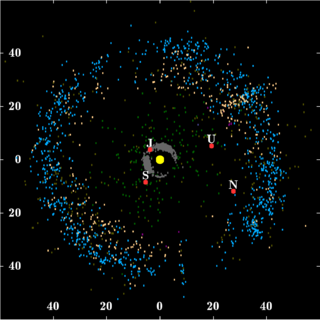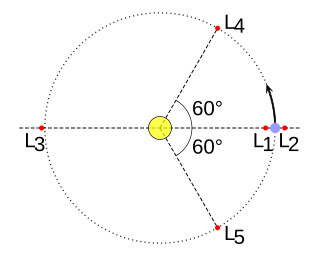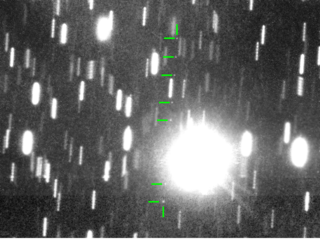In astronomy, the plutinos are a dynamical group of trans-Neptunian objects that orbit in 2:3 mean-motion resonance with Neptune. This means that for every two orbits a plutino makes, Neptune orbits three times. The dwarf planet Pluto is the largest member as well as the namesake of this group. The next largest members are Orcus, (208996) 2003 AZ84, and Ixion. Plutinos are named after mythological creatures associated with the underworld.

In planetary astronomy, a centaur is a small Solar System body that orbits the Sun between Jupiter and Neptune and crosses the orbits of one or more of the giant planets. Centaurs generally have unstable orbits because they cross or have crossed the orbits of the giant planets; almost all their orbits have dynamic lifetimes of only a few million years, but there is one known centaur, 514107 Kaʻepaokaʻawela, which may be in a stable orbit. Centaurs typically exhibit the characteristics of both asteroids and comets. They are named after the mythological centaurs that were a mixture of horse and human. Observational bias toward large objects makes determination of the total centaur population difficult. Estimates for the number of centaurs in the Solar System more than 1 km in diameter range from as low as 44,000 to more than 10,000,000.
2003 YN107 is a tiny asteroid, classified as a near-Earth object of the Aten group moving in a 1:1 mean-motion resonance with Earth. Because of that, it is in a co-orbital configuration relative to Earth.

In celestial mechanics, a horseshoe orbit is a type of co-orbital motion of a small orbiting body relative to a larger orbiting body. The osculating (instantaneous) orbital period of the smaller body remains very near that of the larger body, and if its orbit is a little more eccentric than that of the larger body, during every period it appears to trace an ellipse around a point on the larger object's orbit. However, the loop is not closed but drifts forward or backward so that the point it circles will appear to move smoothly along the larger body's orbit over a long period of time. When the object approaches the larger body closely at either end of its trajectory, its apparent direction changes. Over an entire cycle the center traces the outline of a horseshoe, with the larger body between the 'horns'.

524522 Zoozve (provisional designation 2002 VE68) is a sub-kilometer sized asteroid and temporary quasi-satellite of Venus. Discovered in 2002, it was the first such object to be discovered around a major planet in the Solar System. It has nearly the same orbital period around the Sun that Venus does. In a frame of reference rotating with Venus, it appears to travel around it during one Venerean year, but it orbits the Sun, not Venus.

In astronomy, a trojan is a small celestial body (mostly asteroids) that shares the orbit of a larger body, remaining in a stable orbit approximately 60° ahead of or behind the main body near one of its Lagrangian points L4 and L5. Trojans can share the orbits of planets or of large moons.
In astronomy, a co-orbital configuration is a configuration of two or more astronomical objects orbiting at the same, or very similar, distance from their primary; i.e., they are in a 1:1 mean-motion resonance..

Retrograde motion in astronomy is, in general, orbital or rotational motion of an object in the direction opposite the rotation of its primary, that is, the central object. It may also describe other motions such as precession or nutation of an object's rotational axis. Prograde or direct motion is more normal motion in the same direction as the primary rotates. However, "retrograde" and "prograde" can also refer to an object other than the primary if so described. The direction of rotation is determined by an inertial frame of reference, such as distant fixed stars.

1991 VG is a very small near-Earth object of the Apollo group, approximately 5–12 meters in diameter. It was first observed by American astronomer James Scotti on 6 November 1991, using the Spacewatch telescope on Kitt Peak National Observatory near Tucson, Arizona, in the United States. On 6 December 1991 it passed about 369635 km from the Moon. The asteroid then went unobserved from April 1992 until it was recovered by Paranal Observatory in May 2017. It was removed from the Sentry Risk Table on 1 June 2017.
Paul Arnold Wiegert is a Canadian astronomer, discoverer of minor planets and professor at the University of Western Ontario.
2013 BS45 (also written 2013 BS45) is a horseshoe companion to the Earth like 3753 Cruithne. Like Cruithne, it does not orbit the Earth in the normal sense and at times it is on the other side of the Sun, yet it still periodically comes nearer to the Earth in sort of halo orbit before again drifting away. While not a traditional natural satellite, it does not quite have normal heliocentric orbit either and these are sometimes called quasi-satellties or horseshoe orbits.
2014 OL339 (also written 2014 OL339) is an Aten asteroid that is a temporary quasi-satellite of Earth, the fourth known Earth quasi-satellite.
2013 LX28, is an asteroid, classified as near-Earth object of the Apollo group that is a temporary quasi-satellite of the Earth, the third known Earth quasi-satellite.
2015 SO2 (also written 2015 SO2) is an Aten asteroid that is a temporary horseshoe companion to the Earth, the ninth known Earth horseshoe librator. Prior to its most recent close encounter with our planet (2015 September 30) it was an Apollo asteroid.
2015 XX169 (also written 2015 XX169) is an Apollo asteroid that is a temporary horseshoe companion to the Earth, the tenth known Earth horseshoe librator. A close encounter with the Earth on 14 December 2015 caused the value of the semi-major axis of 2015 XX169 to drift slowly upwards, and the object evolved from an Aten asteroid to an Apollo asteroid about a year after this close approach.
2015 YA is a sub-kilometer asteroid, classified as near-Earth object of the Aten group, that is a temporary horseshoe companion to the Earth. It is the 11th known Earth horseshoe librator. Prior to a close encounter with the Earth on 15 December 2015, 2015 YA was an Apollo asteroid.
A temporary satellite is an object which has been captured by the gravitational field of a planet and thus has become the planet's natural satellite, but, unlike irregular moons of the larger outer planets of the Solar System, will eventually either leave its orbit around the planet or collide with the planet. The only observed examples are 2006 RH120, a temporary satellite of Earth for twelve months from July 2006 to July 2007, and 2020 CD3, which was discovered in 2020. Some defunct space probes or rockets have also been observed on temporary satellite orbits.
2020 VT1 is a small asteroid, classified as a near-Earth object of the Amor group, that is a temporary horseshoe companion to Mars.
2020 PN1 is a sub-kilometer asteroid, classified as a near-Earth object of the Aten group, that is a temporary horseshoe companion to the Earth. There are dozens of known Earth horseshoe librators, some of which switch periodically between the quasi-satellite and the horseshoe co-orbital states.
2020 PP1 is a sub-kilometer asteroid, classified as a near-Earth object of the Apollo group, that is a temporary quasi-satellite of the Earth. There are over a dozen known Earth quasi-satellites, some of which switch periodically between the quasi-satellite and horseshoe co-orbital states.






